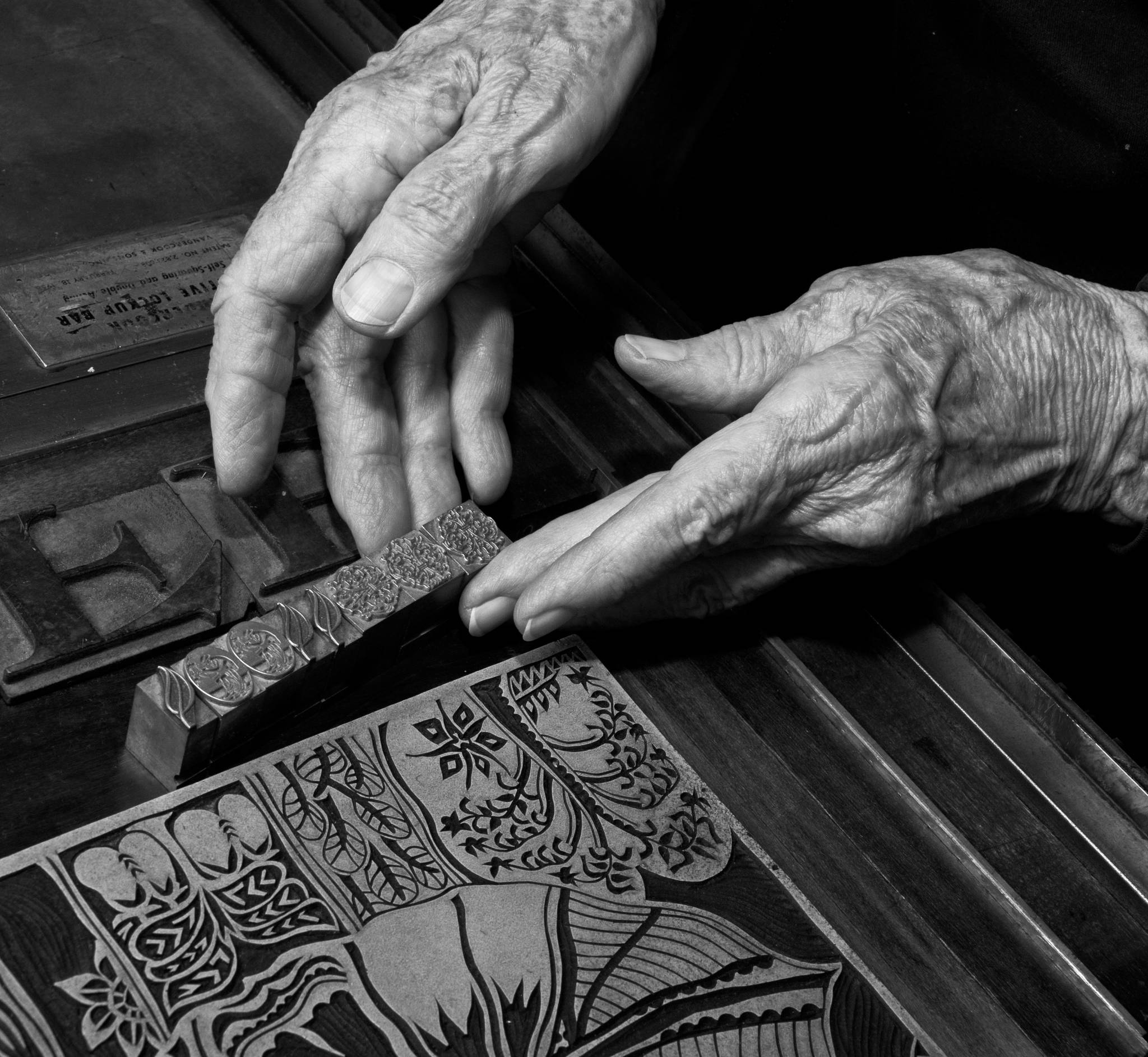By Iris Graville, special to the Weekly.
In honor of over sixty years as a visual artist, Diana Bower is ready to party — and to say “thank you.” The Lopez Island printmaker and co-founder of Chimera Gallery will do both on Aug. 7 from 4-6 p.m. at a public reception there in her honor. Bower’s work has been featured at the artists’ co-operative since she and a handful of other Lopez artists opened the gallery in 1987.
Diana’s hands tell of decades of creating words and images using ancient techniques. Working with X-acto and gouging knives, she’s carved over one hundred linoleum blocks, including one that serves as Chimera Gallery’s logo. A fanciful griffin with the head of a lion, body of a goat, and long, curving tail symbolizes the diversity of artists and personalities from Chimera’s beginning through the present.
Although Bower no longer cuts linoleum blocks, she still enjoys operating her Vandercook Simple Precision SP15 proof press. Letter-by-letter, she spells out words, blessings, and beloved quotes, places them and her hand-cut blocks on the press, and prints bold, inspiring images. She sums up one of the most important lessons she’s learned as a printer in one word. “Proofread!”
Diana is well-known for her prints, called broadsides, which combine hand-carved images with words to convey information as well as her opinions. In recent years, she’s hand-painted colors on hundreds and hundreds of prints. “I can get terribly depressed and worried about the world situation,” she says. Her children, Holly and Dan, taught her inaction is a fruitless path. “You have to take action,” they’ve urged. “My political posters and upbeat broadsides are something I can do.” Making something with her hands, she says, is “good for my mind and spirit.”
Born in New York City in 1930, Diana lived much of her youth in small towns in New York State. She credits her high school art teacher with guiding her into her life’s work and to attend art school at Yale. “When I started at Yale, the art school followed the Beaux Arts tradition — life drawing and portraiture in dark studios. It was grim. I told my papa I had to go to Europe. He said ‘no,’ and I argued and argued with him. Then I made a bargain with him that if I earned my passage, I could go. I did that by working in the village diner.”
After seven months soaking up art in Scotland, England, Paris, and Florence, Diana returned to Yale. “The art school had been transformed. Everything had been painted white, and Josef Albers had established a graphic arts department with brilliant, young instructors. They were so inspired. And they smiled and laughed and got us to do great work. They had a wonderful letterpress, and that’s when I fell in love with type. It was like coming into my own.”
The job in the diner had provided Diana more than her funds for Europe. It was also where she met her late husband, Ted Bower. “He was an architect building Frank Lloyd Wright homes and his own designs. He was quiet, handsome, and intriguing. I gave him extra butter.” They were married in 1953 and headed to India for seven months where she and Ted worked on architecture designs for schools.
Seattle became home next, where Diana was befriended by a family of Japanese-American printers. “Their print shop had lots and lots of type, and they gave me my own little corner. They were incredibly kind and taught me a lot. I started setting type more and more, and I loved it.” Her skill as a printer grew further when she began working with Rachel da Silva, co-founder of Seal Press, Seattle’s first feminist publishing house. Soon Diana became sought after for book design for the presses of Yale and the University of Washington. She also printed posters for civil rights and peace efforts, protested nuclear weapons and was tried in federal court for civil disobedience.
In 1981, Bower bought property on Lopez with a refurbished 1910 farmhouse that became her studio. A wood stove warms two small rooms. Cornflower blue trim accents floor-to-ceiling windows and French doors.
Bower continues to use her art to promote peace and work she admires. She’s well-known as the creator of the signature image of Lopez Island Vineyards and Winery as well as the print, “A Dream of Houses,” for the Lopez Community Land Trust. This old craft that dates back to the fifteenth century sustains Bower. “No one makes me do this,” she says. “It’s why I get up in the morning. It’s that basic – it’s my reward.”
Here’s what Bower wants to thank people for at the upcoming reception. “When I can be present when people react to my work, there’s often a lovely moment of connection,” she says. “Sometimes they put their hands over their hearts, or they’ll read the words and catch their breath a little.”
The show of Bower’s work will be on display daily at Chimera Gallery Aug. 7-Sept. 3. For more information, visit chimeragallery.com.



